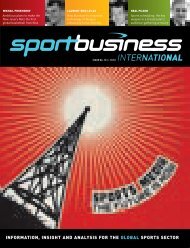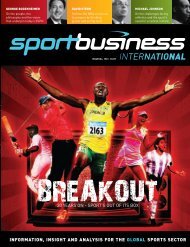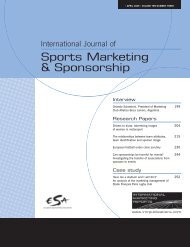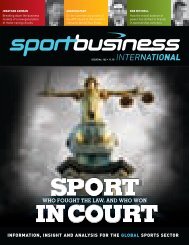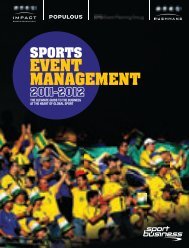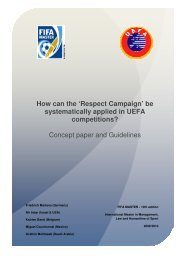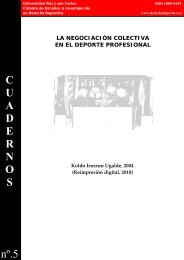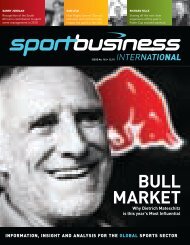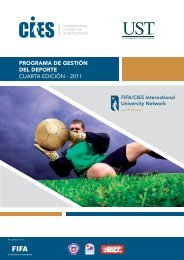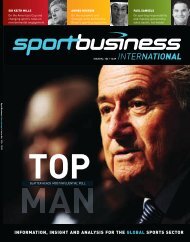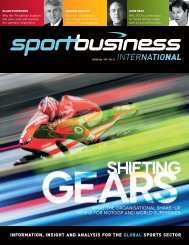The club has to pay a rental fee on their home ground, 117 although they were able to breakeven with ticket sales. Nonetheless, not hav<strong>in</strong>g a club-owned or run stadium makes itextremely difficult for the club to develop the additional revenue streams com<strong>in</strong>g from matchday. Currently, there is no <strong>in</strong>come for the club from park<strong>in</strong>g, cater<strong>in</strong>g, or sponsorshipbanners. Additionally, there is a considerable difference <strong>in</strong> attendance for European matches,requir<strong>in</strong>g the team to rent much larger stadium, such as for the 2009 UEFA Cup F<strong>in</strong>al 118 and<strong>in</strong> 2010, due to UEFA regulations on floodlight<strong>in</strong>g, the Champions League matches wereforced to be played at a completely different stadium. 119 Not hav<strong>in</strong>g a stable venue causes adisconnect for fans and lacks the atmosphere of a true “home” stadium."The club is currently look<strong>in</strong>g <strong>in</strong>to options for gett<strong>in</strong>g their own stadium. Ma<strong>in</strong>ly, thereare two options: the first to develop the club’s tra<strong>in</strong><strong>in</strong>g ground <strong>in</strong>to a stadium. Whiletechnically feasible, the budget for this development is 7-10 million Euros, which the clubcannot f<strong>in</strong>ance. FCR Duisburg believes, their second option is the Sportpark Wedau, a 10 000seat stadium owned by the city. Formerly used by E<strong>in</strong>tracht Dusburg, it is now used purelyfor athletics tra<strong>in</strong><strong>in</strong>g. The club is currently <strong>in</strong> negotiations with the municipality. Withm<strong>in</strong>imal additional development 120and be<strong>in</strong>g a ‘clean’ stadium from a market<strong>in</strong>gperspective, 121 the stadium would appear to be a great source of <strong>in</strong>come for the club, assponsorship could <strong>in</strong>clude items such as stadium signage and cater<strong>in</strong>g opportunities. Whilethis appears to be an ideal situation, there are political issues with the municipality, <strong>in</strong>clud<strong>in</strong>gits previous agreements concern<strong>in</strong>g host<strong>in</strong>g athletics tra<strong>in</strong><strong>in</strong>g. However if these could beresolved dur<strong>in</strong>g the current negotiation, the additional <strong>in</strong>come that could be generated for theclub is estimated to be 150,000-200,000 Euros annually. 122While teams with an affiliation to a larger club tend to benefit from the <strong>in</strong>frastructure<strong>in</strong> place, other clubs struggle to generate more than a marg<strong>in</strong>al revenue stream from theirfacilities. Highlight<strong>in</strong>g FCR Duisburg’s attempts at creat<strong>in</strong>g a home stadium, women’s clubs""""""""""""""""""""""""""""""""""""""""""""""""""""""""117 FCR Duisburg 2001 play their home games at the PCC-stadium of FC Homburg with a capacity of 3,000 .118 The club rented 31,500 Duisburger MSV-Arena, which they almost filled (28,112)119 The Champions League matches were played <strong>in</strong> Oberhausen Stadion Rhe<strong>in</strong>ernergie, 21,000 capacity, whichmet the newly <strong>in</strong>troduced UEFA standards for the Women’s Champions League120 The stadium currently has available park<strong>in</strong>g and VIP boxes, however FCR Duisburg would look <strong>in</strong>toadditionally seat<strong>in</strong>g to be built121 A “clean” stadium mean<strong>in</strong>g it currently has no sponsorship banners or signs.122 Jas<strong>in</strong>ski, Interview, 21, May 2010.$7"
could benefit from a municipality-club agreement to fund their own stadium, and giv<strong>in</strong>g theirfans a place to call home. As noted, teams under the ownership of men’s clubs, often play <strong>in</strong>shared stadiums, so this may be a possibility for these teams as well. The city would have astable and prestigious tenant <strong>in</strong> the stadium, while the club could benefit from the betterfacilities and improved possibilities for <strong>in</strong>come generation.4.4 F<strong>in</strong>ances and OwnershipIn sport<strong>in</strong>g organizations, there are many different types of organizations, each with itsunique challenges and opportunities. One type of structure, the association, is the mostcommon type for sports clubs, but it does h<strong>in</strong>der commercial <strong>in</strong>vestment <strong>in</strong>to the club. 123However, this structure is beneficial for teams who <strong>in</strong>corporate a larger community effort andwant to be protected from the decisions of owners who are not compelled to consult themember/fans <strong>in</strong> any way. Some states give additional tax and rates benefits to associations. Inaddition, some leagues such as the Toppserien <strong>in</strong> Norway <strong>in</strong>sist on clubs be<strong>in</strong>g anassociation. A co-operative has the similar benefits of an association, however its “one man,one vote” could prove to lack the efficiency of decision mak<strong>in</strong>g that is necessary. The thirdstructure is the corporation, which is a commercial entity based on transferable ownership.This allows for owner <strong>in</strong>vestment and sometimes, easier access to f<strong>in</strong>ance for capital<strong>in</strong>tensiveprojects. 124 In an <strong>in</strong>dustry that seldom shows a profit, the ownership model does notoffer a serious return on <strong>in</strong>vestment except for the potential capital ga<strong>in</strong> <strong>in</strong> future sell<strong>in</strong>g ofthe club, hence own<strong>in</strong>g a football club is more of a status symbol than a shrewd f<strong>in</strong>ancial<strong>in</strong>vestment.In the same way there are many structures <strong>in</strong> other sports, the f<strong>in</strong>ances and ownershipvary greatly <strong>in</strong> European women’s club football, which makes them almost <strong>in</strong>comparable.One item to note as well is the large discrepancy between the top clubs and those develop<strong>in</strong>garound Europe. Budgets with<strong>in</strong> the clubs analyzed range from Olympique Lyonnais Fem<strong>in</strong><strong>in</strong>elist<strong>in</strong>g <strong>in</strong> their f<strong>in</strong>ancial statement <strong>in</strong> 2008 a budget of 2.8 million Euros, to the average Dutchbudget, <strong>in</strong>clud<strong>in</strong>g AZ Alkmaar, at 150,000 Euros. 125 There are two most common structures,""""""""""""""""""""""""""""""""""""""""""""""""""""""""123 In an association, one cannot distribute dividends.124 Kuhn, Francois. New Forms of Organisation, Lecture given to <strong>FIFA</strong> Master. <strong>CIES</strong>. March 2010.125 Olympique Lyonnais, Annual F<strong>in</strong>ancial Report 2008/2009. Janssens, Interview, 10, May 2010.%8""
- Page 3: AcknowledgementsThe FIFA Master has
- Page 7 and 8: 4.5.4 Radio and Television Presence
- Page 9 and 10: !"#$%&'()*(+,%'-./0%1-,(1.1 “The
- Page 11 and 12: 1970 the General Assembly of the DF
- Page 13 and 14: 2.1.3 Increase in interest for nati
- Page 15 and 16: Similarly, UEFA has included gender
- Page 17 and 18: 2.2 Existing Academic Research on W
- Page 19 and 20: European context, with a strong emp
- Page 21: "“Røa players have between 1-yea
- Page 24 and 25: performs a sporting role as their m
- Page 26 and 27: Such occasions therefore help provi
- Page 28 and 29: implemented to create a distinct id
- Page 30 and 31: "• marketing and media• sponsor
- Page 32 and 33: Chapter 4: Data Analysis4.1 Adminis
- Page 34 and 35: skilled professional, such as websi
- Page 36 and 37: identified players with talent. 103
- Page 38 and 39: and women to participate in organiz
- Page 42 and 43: full ownership by a larger club, wh
- Page 44 and 45: Only one or two clubs or federation
- Page 46 and 47: 4.5.5 Print Media PresenceAnother p
- Page 48 and 49: the sporting entity. This is why it
- Page 50 and 51: sponsorship categories to attract r
- Page 52 and 53: Table 3: Average Attendance - Speci
- Page 54 and 55: merchandise available through their
- Page 56 and 57: that the clubs continue this relati
- Page 58 and 59: growing healthy relationship betwee
- Page 60 and 61: 5.4 Growing costs for clubs, stayin
- Page 62 and 63: Without taking anything away from t
- Page 64 and 65: Chapter 6: RecommendationsThe follo
- Page 66 and 67: values could be utilised by compani
- Page 68 and 69: 6.4 Knowledge and resource sharing:
- Page 70 and 71: #economically self-sufficient, most
- Page 72 and 73: !"#$"%&'()*+,#Advanced Learners Dic
- Page 74 and 75: FFC Turbine Potsdam (2010) TurbineT
- Page 76 and 77: Soccerway, Europe - UEFA Women's Ch
- Page 78 and 79: !""#$%&'#(!""#$%&'()(*(+,+!(-&.(/01
- Page 80 and 81: !""#$%&'()(*()+,+-,,(./0!(1234(56$7
- Page 82 and 83: !"##!""#$%&'()*+(,(-./"0#(12#34&5$$



